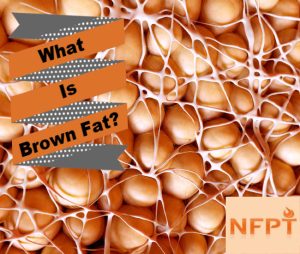
“Fat” can be a “4-letter word” in terms of the negative connotation that leaps into our minds at the mere mention of adipose tissue. However, as with most generalities in life, fat cells are not always the enemy. It is time to meet brown fat, a substance in the human body associated with keeping us lean.
Color and Composition
The extraneous “fluff” of which most individuals complain is referred to as white fat. White fat cells possess one single lipid droplet, whereas their brown counterparts are comprised of multiple small lipid droplets and significant amounts of iron-containing mitochondria. It is this iron content that lends this darker adipose tissue its color. Its higher content of unmyelinated nerves enables brown fat to provide sympathetic stimulation to the fat cells.
The Brown Fat Burning Effect
Excess white fat cells which find their way to the abdominal region are typically linked to a higher risk of metabolic disorders. Such cells are the body’s way of storing excess calories. When we consume more calories than the body burns, it converts these cells into energy reserves in the form of white fat. Conversely, brown fat generates heat by burning calories, a process known as thermogenesis.
The Chill Factor
Preliminary research is pointing toward brown fat as a potential treatment for obesity and metabolic syndromes, but this study has a long way to go. A group of scientists from the Universite de Sherbrooke in Canada discovered that individuals whose bodies contain higher levels of brown fat tend to start shivering at lower temperatures; such results prompted further experimentation, suggesting that exposure to cold temperatures (~ 66 degrees F.) for just two hours each day might facilitate recruitment of brown fat cells.
Brown Cells, Metabolism, and Weight Loss
Active brown cells are capable of burning an extra 250 calories a day. This number represents a burning rate increase of 1.8x. If one were able to burn an extra 200 or 300 calories a day this way, he or she could notice a loss of one pound of body fat in a few weeks’ time. The calorie-burning boost from brown fat could potentially be enough to reverse the weight gain associated with the aging process, and help older individuals maintain the body fat percentage they enjoyed in their younger years.
Human brown adipose tissue is highly sensitive to insulin; as we now know, insulin resistance tends to lead to obesity and diabetes. A reduction in body weight seems to improve cold-induced activation of these cells. By increasing the body’s metabolic activity, our mitochondria-rich fat might mitigate the inevitable metabolic slowdown that occurs during dieting.
Research performed on mice suggests that a protein called irisin may help transform white fat cells to brown. It turns out that sedentary individuals produce far less irisin compared to those who exercise often. Specifically, levels of brown fat increase during intense aerobic interval training.
Scientists continue to investigate the most promising manner in which to recruit additional brown fat cells. In the meantime, counseling clients on the merits of clean meals and remaining as active as possible lead the pack in terms of prudent advice. We may even choose to mention that cold-temperature exposure…but do not be surprised if this is not met with tremendous positive feedback!
References:
https://www.ncbi.nlm.nih.gov/pubmed/30141098
https://www.medicalnewstoday.com/articles/240989.php
https://www.healthline.com/health/brown-fat#1
Cathleen Kronemer is an NFPT CEC writer and a member of the NFPT Certification Council Board. Cathleen is an AFAA-Certified Group Exercise Instructor, NSCA-Certified Personal Trainer, ACE-Certified Health Coach, former competitive bodybuilder and freelance writer. She is employed at the Jewish Community Center in St. Louis, MO. Cathleen has been involved in the fitness industry for over three decades. Feel free to contact her at trainhard@kronemer.com. She welcomes your feedback and your comments!

